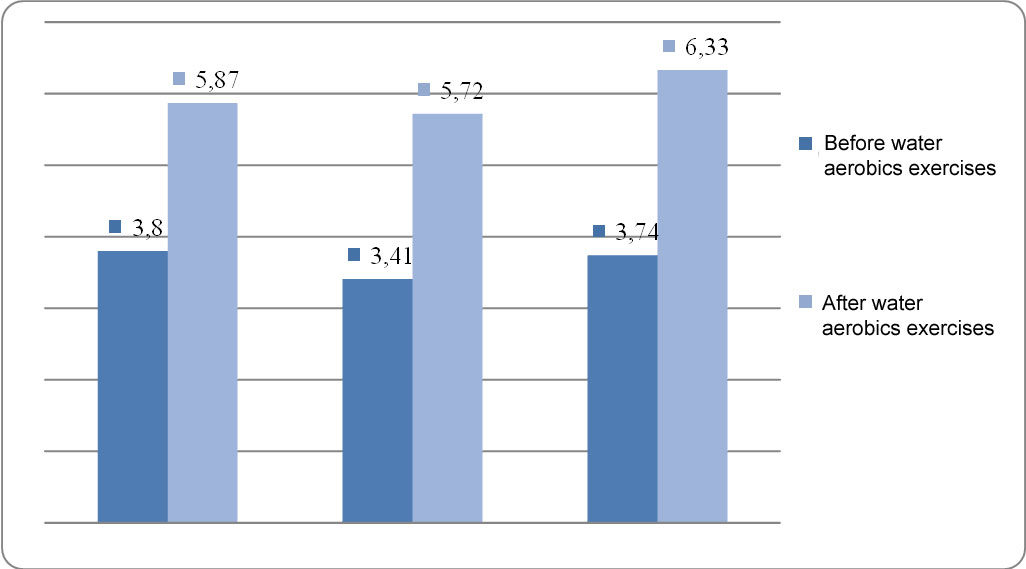Benefits of water aerobics practices in academic physical education of female students
Фотографии:
ˑ:
PhD, Associate Professor J.V. Korichko1
Associate Professor S.A. Davydova1
PhD, Associate Professor A.R. Galeev1
1Nizhnevartovsk State University, Nizhnevartovsk
Keywords: water aerobics, sets of exercises, physical education, female students.
Introduction. Academic educational process is associated with great intellectual and psychological strain, hypokinesia and stressful situations for the students. Motor activity deficit has an especially negative impact on the health of students, particularly females. Currently female students have a choice from a wide range of tools and forms of physical training taking into account their interests [1, 2, 5, 6]. In particular, an increased interest of female students in water aerobics can be noted since it is a popular kind of motor activity providing great opportunities for effectively solving the issues of physical education including the movement culture cultivation [7].
The process of encouraging interest in physical education is a multi-stage one: from the first elementary hygienic information and skills to profound knowledge of the theory and methodology of physical education in the university.
The study objective was to prove experimentally the positive effect of water aerobics classes on physical wellbeing of female university students.
Research methods and structure. Subject to experiment were second and third year female students of Nizhnevartovsk State University aged 18-19 years, who attended water aerobics classes at the university.
A questionnaire survey of the female students was conducted to identify their motives for water aerobics training.
Sets of exercises were designed in the course of the study focused not only on the traditional water aerobics elements but also on the rational use of exercises developing various respiration practices and breathing-with-movement harmonizing practices. The sets included exercises to learn swimming as well as ones having local impact on various muscle groups, sets of exercises aimed at the ability to distinguish between the states of muscle tension and relaxation which is necessary for exercising in the water. The sets of water aerobics exercises were designed based on the methodological recommendations of T.G. Polukhina [8], O.B. Galeeva and A.S. Kazyzaeva [3, 4].
Swimming exercises and dynamic movements associated with dancing practices were used in the warm-up of the water aerobics classes, the main part contained exercises of local effect on various muscle groups and the cool-down consisted of stretching, relaxation and breathing exercises.
The classes took place in shallow (120-140 cm), intermediate (140 – 150 cm) and deep (150 cm and deeper) sections of the pool. Sets of water aerobics exercises consisted of ones for development of arms and back muscles, lateral, inner, back and front of the thigh, and abdominal muscles. Exercises performed in different positions with regards to the support were included: standing, sitting or lying on the swimming pool nosing; in the water at the side of the pool using arms or back as support; standing on the bottom of the swimming pool on one or two legs, with one’s feet flat or on tiptoe; without support, when the swimming pool bottom is not used as a support.
The exercises were performed in various positions of the body in the water, such as vertical; horizontal (face down, face up, on the side); in the sitting position; transitional - for example, when changing the position from horizontal to vertical or from sitting to lying down; with various bends of 30, 45, 90 degrees. All the exercises were combined into blocks divided by swimming exercises. The sequence of the exercises in the blocks in combination with the swimming ensured alternation of exercise and rest, tension and relaxation of various muscle groups, switching from acyclic to cyclic types of activity.
The level of impact water aerobics classes have on the wellbeing, activity and mood of female students was determined using the WAM method.
Results and discussion. The questionnaire survey showed that the respondents consider the main motivations for water aerobics classes as follows: health improvement (74%), physical appearance improvement (67%), physical condition enhancement (65%), working capacity increase (62%), switching from sedentary learning to motor activity (53%), socializing (51%), and mood improvement (48%).
The positive impact of water aerobics classes on the wellbeing, activity and mood indices of the female students was revealed when analyzing the data of the test conducted using the WAM method (Figure 1).

Figure 1. Results of the express assessment of the mood of female students using the WAM method.
Analysis of the data obtained by the express assessment using the WAM questionnaire revealed that water exercises to music during physical education classes not only enhance the students' interest in and need for motor activity, but also improve their wellbeing, activity and mood indices.
Based on the pulsometry results we identified groups of exercises that cause various fluctuations in the heart rate (HR). In the 1st block (using a fixed support) the maximum HR increase is caused by vastus lateralis and abdominal-toning exercises (up to 140 beats/minute) as well as hamstring and inner thigh muscles (up to 132 beats/minute), arms and back (up to 125 beats/minute) exercises.
In the 2nd block (using swimming boards) high HR values were recorded after performing inner thigh exercises (up to 138 beats/minute) and abdominal and anterior thigh (up to 127 beats/minute), vastus lateralis (up to 120 beats/minute) and hamstring (up to 117 beats/minute) exercises.
The maximum HR increase in the 3rd block (with pool noodles) was caused by anterior thigh exercises in a vertical position (up to 155 beats/minute); a heart rate increase up to 145 beats/minute was observed in abdominal-toning exercises, heart rate of up to 130 beats/minute – in inner thigh and vastus lateralis exercises, and heart rate of up to 110 beats/minute – in hamstring exercises.
The highest HR values in the 4th block (with floating belts) were recorded after anterior thigh, hamstring and arms exercises performed in a vertical position (up to 152 beats/minute); inner thigh and vastus lateralis exercises performed in a vertical position cause an increase in heart rate of up to 132 beats/minute; abdominal-toning exercises – up to 120 beats/minute.
Based on the obtained data we calculated the energy expenditure of female students in each block of exercises using the Buskirk method (1960). We found that female students spend about 300 – 350 kcal/hour per one water aerobics class which corresponds to the data listed in scientific and methodological literature on the estimated expenditure when performing keep-fit exercises as part of controlled physical loads. For comparison one can cite data indicating that 450 – 500 kcal/hour are spent on average in one conventional aerobics class.
Analyses and comparison of the energy expenditure rates for water aerobics and conventional aerobics classes show that despite the higher kcal/hour expenditure at conventional aerobics classes, not all females are recommended to experience physical loads in the high-intensity zones – for various reasons (health, functional state of the cardiovascular system).
Conclusion. Female students appreciate special water aerobic exercises associated with creative sets of water dancing practices. It should be noted that the proposed set of exercises is customizable to allow the coach spur interest of the students and facilitate the practices by duly individualized exercise design and management.
References
- Aleksandrova R.V. Issledovanie vliyaniya uprazhneniy na serdechno-sosudistuyu sistemu zhenschin 18-35 let v usloviyakh glubokogo basseyna (rezultaty poiskovogo eksperimenta) [Study of effect of exercise on cardiovascular system of women aged 18-35 years in deep swimming pool (searching experiment results)]. Nauchnye issledovaniya i razrabotki v sporte: Vestnik aspirantury SPbGAFK im. P.F. Lesgafta [Scientific research and developments in sports: Bulletin of postgraduate courses in P.F. Lesgafta SPbSAPC], 1998, pp. 84-85.
- Galeeva O.B. Ozdorovitelnaya trenirovka zhenschin 18-28 let, zanimayuschikhsya gidroaerobikoy. Avtoref. dis. kand. ped. nauk [Fitness training for women aged 18-28 years engaged in water aerobics. PhD diss. abstract]. Omsk, 1997, 24 p.
- Galeev A.R., Starchenko K.A. Primenenie sredstv akvaaerobiki na zanyatiyakh s zhenschinami zrelogo vozrasta [Water aerobics classes for middle-aged women]. Mater. V Vseros. nauch.-prakt. konf. s mezhdunar. uchastiem, posvyaschennoy 20-letiyu fakulteta fizicheskoy kultury i sporta Nizhnevartovskogo gosudarstvennogo universiteta "Perspektivnye napravleniya v oblasti fizicheskoy kultury, sporta i turizma" [Proc. V Rus. res.-pract. conf. with intern. participation, dedicated to the 20th anniversary of physical culture and sports faculty of Nizhnevartovsk State University "Perspective directions in physical culture, sports and tourism"], 2015, pp. 52-54.
- Kazyzaeva A.S., Galeeva O.B. Osobennosti zanyatiy akvaaerobikoy s razlichnym kontingentom. Ucheb. posobie [Water aerobics programs for different contingents of trainees. Study guide]. Omsk: SSUPC publ., 2012, 187 p.
- Korichko J.V. Organizatsonno-metodicheskie aspekty provedeniya zanyatiy po fizicheskoy kulture s elementami fitnesa so studentkami vuza [Procedural-methodical aspects of fitness-driven physical education lessons with female students]. Mater. V Vseros. nauch.-prakt. konf "Traditsii i innovatsii v obrazovatelnom prostranstve Rossii, KhMAO-Yugry i NVGU" [Proc. V Rus. res.-pract. conf. "Traditions and innovations in educational space of Russia, KhMAR-Yugra and NVSU], 2016, pp. 10-12.
- Krasnikova O.S., Pashchenko L.G., Davydova S.A. Sravnitelny analiz fizicheskoy podgotovlennosti studentok v usloviyakh realizatsii svobodnogo vybora fizkulturno-sportivnoy spetsializatsii [Comparative analysis of physical fitness of female students during their free choosing of sports specialization]. Teoriya i praktika fiz. kultury, 2015, no. 12, pp. 37-39.
- Lubysheva L.I. Fizicheskaya i sportivnaya kultura: soderzhanie, vzaimosvyaz i dissotsiatsiya [Physical and sports culture: content, interrelation and dissociation]. Teoriya i praktika fiz. kultury, 2002, no. 3, pp. 11-14.
- Polukhina T.G. Klassifikatsiya i tipologiya uprazhneniy v akvaaerobike kak osnova dlya razrabotki tekhnologii obucheniya. Avtoref. dis. kand. ped. nauk [Classification and typology of water aerobics exercises as a basis for training technology development. PhD diss. abstr.]. Moscow, 2003, 23 p.
Corresponding author: niideu@mail.ru
Abstract
The article explores the ways to encourage interest of female students in water aerobics promoted as a popular academic sport activity. It demonstrates the need for a high priority to be given to aerobic exercises viewed as an efficient practice to energize, improve wellbeing and mood of trainees and secure optimal physical loads for female students. In addition to traditional elements, the sets of modern water exercises include special respiration practices and breathing-with-movement harmonizing practices.
The study data and analyses showed that the female students appreciate special water aerobic exercises associated with creative sets of water dancing practices. It should be noted that the proposed set of exercises is customizable to allow the coach spur interest of the students and facilitate the practices by duly individualized physical load design and management.


